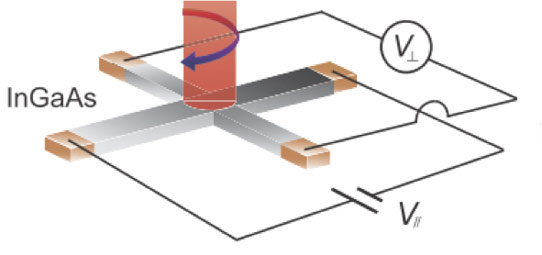- News
2 September 2014
Efficient tunable spin-charge converter made of GaAs
The research group of professor Jairo Sinova of the Institute of Physics at Johannes Gutenberg University Mainz, in collaboration with researchers from the UK, Prague, and Japan, has realised for the first time a new, efficient spin-charge converter based on gallium arsenide (N. Okamoto et al, ‘Electric control of the spin Hall effect by intervalley transitions’, Nature Materials, published online on 10 August 2014; DOI:10.1038/nmat4059).
Spintronics not only makes use of the electron’s charge to transmit and store information but it also takes advantage of its spin (rotation of the electron around its own axis), which generates a magnetic field like a small magnet. In some materials, electron spins spontaneously align their directions, leading to ferromagnetism (e.g. in iron). Additionally, ‘spin-up’ or ‘spin-down’ directions can be used to represent two easily distinguishable states (0 and 1) used in information technology (e.g. for memory applications such as computer hard discs).
Making use of electron spin for information transmission and storage enables the development of electronic devices with new functionalities and higher efficiency, but the electron spin must be manipulated precisely (aligned, transmitted and detected). The work of Sinova and his colleagues shows that it is possible to do so using electric fields rather than magnetic ones. Thus, the very efficient, simple and precise mechanisms of charge manipulation that are well established in semiconductor electronics can be transferred to spintronics, hence combining semiconductor physics with magnetism.
Spin-charge converters are essential tools for this, since they can transform charge currents into spin currents, and vice versa. The main principle behind these converters is the spin-Hall effect. Sinova had already been involved in the prediction and discovery of this relativistic phenomenon in 2004.
The spin-Hall effect appears when an electric field drives electrons through a semiconductor plate. In the classical Hall effect, the interaction of moving electrons and an external magnetic field forces the electrons to move to one side of the plate, perpendicular to their original direction, yielding the Hall voltage between either side of the plate. In the spin-Hall effect, electron spins are generated by irradiating the sample with circularly polarised light. The electron spins are then parallel or antiparallel, and their direction is perpendicular to the plate and the direction of movement. The moving electron spins are now forced to one or the other side of the plate, depending on the spin orientation. The driving force behind this is the spin-orbit coupling, a relativistic electromagnetic effect that influences moving electron spins. This leads to the separation of both spin orientations.
To make practical use of this effect, it is essential to get highly efficient spin separation. Up to now, platinum has been the most efficient spin-charge converter material, as it is a heavy metal, and the spin-orbit coupling of heavy metals is known to be especially strong due to the large amount of protons (positive charge) in their core.

Picture: Tunable spin-Hall angle device based on GaAs through field-induced intervalley repopulation
Now, Sinova and his colleagues have shown that GaAs can be as efficient as a spin-charge converter as platinum, even at room temperature (important for practical applications). Moreover, the researchers have demonstrated for the first time that the creation or detection efficiency of spin currents can be tuned continuously by varying the electric field that drives the electrons (important in real devices).
As theoretical calculations by the Sinova group have shown, the reason for this lies in the existence of certain valleys in the conduction band of the semiconductor material. Applying a higher electric field enables a transition from one valley to the other. Since the spin-orbit coupling is different in each valley, a transition also affects the strength of the spin-Hall effect. By varying the electric field, the researchers can distribute the electron spins across the different valleys, varying the efficiency of the spin-charge converter.
Taking into account the valleys in the conduction band opens up new ways to find and engineer highly efficient materials for spintronics, say the researchers, especially since existing semiconductor growth technologies are capable of engineering the energy levels of the valleys and the strength of the spin-orbit coupling (e.g. by substituting gallium or arsenic with other materials like aluminium).
www.nature.com/nmat/journal/vaop/ncurrent/full/nmat4059.html
www.sinova-group.physik.uni-mainz.de


